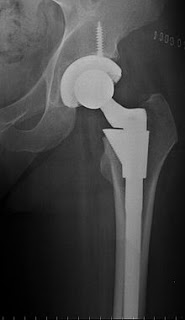by Shari
 |
| X-Ray of Hip Replacement from Wikimedia |
Nina asked me to add to Baxter’s post Arthritis of the Hip Joint about what the next step might be when your own self care management techniques are not as effective and your quality of life is severely impacted. I thought I would give some background about the elective procedure of total hip replacement and why people might elect to have it done. I see a lot of total hip replacements in my work as a home health physical therapist, and I also do have yoga students who come to my class either after the procedure or before hand as they are preparing themselves for the surgery.
As background, here is what the Mayo clinic says about hip replacement surgery:
“Hip replacement surgery, also called total hip arthroplasty, involves removing a diseased hip joint and replacing it with an artificial joint, called a prosthesis. Hip prostheses consist of a ball component, made of metal or ceramic, and a socket, which has an insert or liner made of plastic, ceramic or metal. The implants used in hip replacement are biocompatible — meaning they’re designed to be accepted by your body — and they’re made to resist corrosion, degradation and wear.
The goal of hip replacement surgery is to relieve pain and increase the mobility and function of a damaged hip joint. If a stiff, painful hip joint has forced you to cut back on everyday activities, successful surgery may allow you to resume them. Conditions that can damage the hip joint, sometimes necessitating hip replacement surgery, include:
- Osteoarthritis
- Rheumatoid arthritis
- Broken hip
- Bone tumor
- Osteonecrosis, which occurs when there is inadequate blood supply to the ball portion of the hip joint
To perform a hip replacement, your surgeon:
- Makes an incision over the front or side of your hip, through the layers of tissue
- Removes diseased and damaged bone and cartilage, leaving healthy bone intact
- Implants the prosthetic socket into your pelvic bone, to replace the damaged socket
- Replaces the round top of your femur with the prosthetic ball, which is attached to a stem that fits into your thighbone
Your new, artificial joint is designed to mimic the natural, gliding motion of a healthy hip joint. “
 |
| Artificial Joint from Wikimedia |
Techniques for hip replacement are evolving. As surgeons continue to develop less invasive surgical techniques, the hope is that these techniques might reduce recovery time and pain compared with standard hip replacements. However, studies comparing the outcomes of standard hip replacement with those of minimally invasive hip replacement have had mixed results.
Choosing an orthopedist to perform your surgery is a very personal decision and we all research our concerns in different manners. Please, though, when you have found a surgeon that you want to work with, make sure you discuss the different types of hip replacement surgeries that they may perform so you understand clearly the advantages and disadvantages that each surgical procedure presents. Be particular that the surgeon understands your own particular yoga practice and what it entails. Bring pictures of poses that you currently do (or have done) and make sure the doctor understands the stresses you place on your hip joint. Telling a physician who doesn’t do yoga “I do yoga” isn’t enough, so show him or her the positions your hip needs to be able to move through.
The surgical options that exist are very different in what the post operative limitations are and the longer standing limitations that the post replacement hip might present you with.
The basic categories of total hip replacement are either:
- posterior lateral approach
- anterior lateral approach
- anterior approach
- minimally invasive anterior approach or minimally invasive posterior approaches
These are all different, but as far as hip precautions go there are no hip precautions for the anterior approaches.
Now this important for the practice of yoga. Which approach is recommended for your particular situation is going to affect your asana practice. Please ask your surgeon what your post-operative physical limitations are and for how long. Make sure you learn how to safely get up and down from the floor so as to not dislocate your new hip and that you learn the specific precautions associated with your category of hip replacements. The key is that you learn to identify what position is your hip in when you do your poses and you need to think of both legs when you do each side (don’t just focus on the surgical side).
In the more traditional posterior or posterior lateral approach there are limitations on hip flexion, adduction and internal rotation. That means that if you combine these three positions you are more apt to dislocate your prosthetic hip because the muscle support is weakened by the surgical procedure. That is definitely going to affect your asana practice. Poses you might want to not do for approximately six months would be: Standing Forward Bend (Uttanasana), Eagle pose (Garudasana), Cow-Face pose (Gomukhasana), and Child’s pose (Balasana). Gentle backbends generally are okay for posterior/posterior lateral hips.
For anterior lateral hips the precautions will be very different. Typically hip extension and hip abduction will be affected and you don’t want to be aggressive in these combined movements. So start thinking about your backbends and standing poses. Remember that the position of the front and the back legs are very different in the standing poses. The front hip may be placed into positions of flexion and external rotation and abduction but the back hip may be in extension with external rotation.
For anterior hip replacement surgeries the doctor will typically tell you that you have no restrictions but that doesn’t mean you are going to jump back into your asana practice. The hip is going to be sore and painful because of the surgical trauma (though it is less in this procedure than some of the other ones I talked about because there is no actual muscle cutting in this procedure but the muscles are certainly stretched as they are moved for the surgery).
So now armed with your knowledge of what type of hip surgery you have had, and what your physical restrictions are and for how long, consider the critical importance of studying with a teacher who can assist you in practicing safely. Knowing what props to use and when are important, and so is knowing how deep to go into a pose. In addition, different surgeries have different time frames for returning to asana practice but the rule of thumb to return to any activity post operatively is how you feel. You can get time estimates on when to resume an activity but the bottom line is your own healing process and energy level. As always respecting your energy level and not be overly aggressive as you return to your asana practice is crucial.
In my clinical experience I have never had a client tell me that he or she is sorry to have undergone this surgery. In all medical procedures, knowledge, mental and emotional preparation and conviction in your choice of action go a long way towards healing. That certainly sounds like an engaged yoga practice off of the mat!
Follow Yoga for Healthy Aging on Facebook ° To order Yoga for Healthy Aging: A Guide to Lifelong Well-Being, go to Amazon, Shambhala, Indie Bound or your local bookstore.


Thank you for this post! This information is needed. I recently attended a very informative workshop , with Mary Pafford and Sarahjoy Marsh (who is both a yoga instructor and because of a serious car accident, owner of a "bionic hip"). Several other participants had hip replacements,as well. Even years and many different modes of physical therapy later, there can be pain and limitations , not only the in the joint , but even more tenaciously, in the tissues around it. We looked at a new ways to perform yoga asana, with respect to,and lightness in the hips. Hip replacements are becoming more common, and yoga instructors are more likely to find students with hip replacements in class. For more in depth information , I'd recommend contacting Sarahjoy Marsh(www.dayafoundation.org) or Mary Pafford (www.maryyoga.com )
Yeah… No restrictions would have me jumping headfirst into my old practices had I not read this thanks for the info
Nice combo to strengthen my hip replacement. definitely will consider yoga.
Thanks for sharing this! It is good to know that even people who’ve had hip surgeries can still do yoga, although it may be limited on some poses. Can yoga be a form or alternative for physical therapy post-hip surgery as well?
Sienna Christie
This is very informative post! Thank you for sharing. Many patients having hip replacement surgery with different cases and reasons. Yoga is helpful to strengthen your muscles on your hips and legs but as recommend to your therapist and your doctor. In addition, there are some patients who have had hip replacement systems were suffering from pain due to the risk and complications associated with the devices, this usually occur after a year and more.
-Hart-
Hi
I am a relatively new yoga instructor that teaches Gentle Hatha to (mostly) seniors.
Recently, a gentleman came in with bilat hip replacements from 10 and 12 years previous. He rides his bike and is in pretty good shape for a gent in his 60's.
His hips were replaced by a posterior approach.
How cautious do I need to be with this man? Do we modify mostly in the early days after the operation? Of course, I've modified the asanas to his ability and told him to not push it to the extreme. So is it fresh post op that we worry mostly about or for decades following?
Thanks!
Well spoken words! On July 24,2013 I traveled to India for a total hip replacement due to necrosis of my hip due to auto accident 8-9 years ago. I teach & do yoga daily. Yes, one does need to be careful & communication is key! Educate yourself on the medical expectations of different hips & procedures.
I happened to the exception due to my device( replacement) the surgeon who gave me full ROM within the first week…. was walking stairs & had my knee to chest….. around six months can return to running/ jogging….his passion in technique & helping others really is a blessing!
Pamela, please tell me more about the type of procedure you had done. Anterior? Lateral? That you are running/jogging again in additon to practicing daily and teaching just lifted my heart.